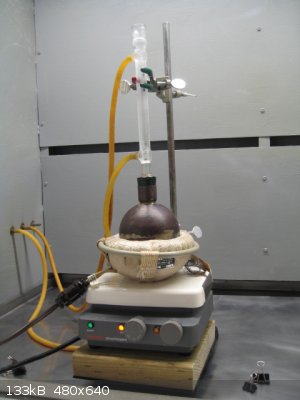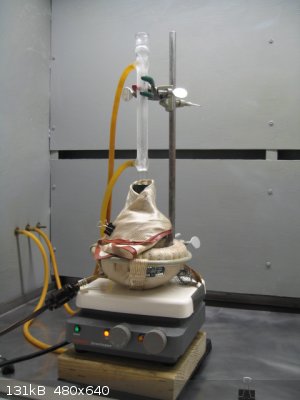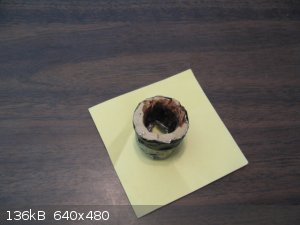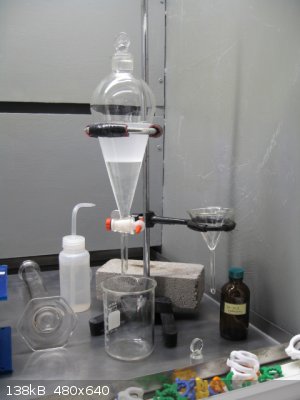Magpie
lab constructor
    
Posts: 5939
Registered: 1-11-2003
Location: USA
Member Is Offline
Mood: Chemistry: the subtle science.
|
|
preparation of hydrazine hydrate
Following Vogel’s procedure (ref 1) I have prepared nominal 90-95% hydrazine hydrate at a 2/3 scale.
NH2-NH3-HSO4 +2NaOH --> NH2-NH2•H2O + Na2SO4 + H2O
1. Reagents
147g hydrazine sulfate
107g NaOH
50 mL water
179 mL xylene
2. Special Equipment
fume hood - hydrazine is highly toxic
500mL copper round bottom flask
3. Procedure
a. Reaction at Reflux.
A 500mL copper RBF was used as a reaction vessel. An egg-shaped magnet stir bar was added. This vessel was set up with a 19/22 reflux condenser
(20cm) using a tin foil covered bored cork (note 1) as adapter.

Synthesis of hydrazine hydrate – unlagged

Synthesis of hydrazine hydrate
The hydrazine sulfate and NaOH were added to the RBF in that order. The 50 mL of water was then added in 10 mL portions through the condenser over a
period of 5 minutes. This generated a great deal of heat and a small amount of hydrazine was seen escaping the top of the condenser. The hood fan
was on, of course, as hydrazine is highly toxic. The reactants were then heated at reflux for 1.5 hours using a mantle. The reactants were stirred
with a magnetic stirrer throughout the reaction.
b. Distillation
The condenser was then set for downward distillation. The distillate temperature rose as high as 133°C then dropped off. Heating was stopped at
this point and the condensate left overnight in the 250mL receiving flask.
c. Azeotropic Distillation
The distillate was then transferred to a 500mL RBF and 179mL of xylene was added along with an egg-shaped stir bar. The stirred biphasic mixture was
distilled until 250mL of water/xylene was collected. Final condensate temperature was 102°C.
4. Results
49g of aqueous hydrazine hydrate was collected. A 1mL aliquot of this was titrated with 0.84N HCl to a methyl orange endpoint. This indicated a
concentration of 79.6% hydrazine hydrate.
Attachment: php4YYoVE (145kB)
This file has been downloaded 958 times
hydrazine hydrate residue
5. Discussion
An electric mantle was used instead of the free flame prescribed by Vogel. This seemed to work well.
The tin foil cork adapter was somewhat deteriorated on the inside surface. This was not covered with tin foil. A bored EPDM rubber stopper might
work just as well or better.

Tin foil covered cork ( post synthesis)
6. Waste Management
The residue in the copper pot consisted of Na2SO4 and residual hydrazine hydrate. This was diluted with water then poured into a large volume of
diluted NaOCl bleach. Some bubbles were formed and assumed to be N2 per ref 2.
N2H4 + 2OCl- --> N2 + 2Cl- + 2H2O
The xylene was separated from the water using a separatory funnel. It is drying over anhydrous Na2SO4 for reuse.

Water + xylene distillate
7. References
1. Practical Organic Chemistry, 3rd ed (1956) by Arthur I Vogel (p. 190).
2. Prudent Practices for Disposal of Chemicals from Laboratories, (1983), National Research Council (pp. 93-94).
Note: 1. The tin foil was a wine bottle cork covering obtained from a vintner.
Comments, questions, and suggestions are encouraged.
[Edited on 21-8-2016 by Magpie]
[Edited on 21-8-2016 by Magpie]
The single most important condition for a successful synthesis is good mixing - Nicodem
|
|
|
DJF90
International Hazard
    
Posts: 2266
Registered: 15-12-2007
Location: At the bench
Member Is Offline
Mood: No Mood
|
|
You never cease to amaze, Magpie! Couldn't believe my eyes when I saw the copper rbf. Was that a custom fabrication job or an "off the shelf" item (if
so from where?)? I was thinking along the lines of using a copper-mirrored borosilicate flask; do you think that would be a suitable substitute? Have
you calculated your %th yield yet?
|
|
|
Texium
Administrator
       
Posts: 4508
Registered: 11-1-2014
Location: Salt Lake City
Member Is Offline
Mood: PhD candidate!
|
|
He has a thread about that flask: https://www.sciencemadness.org/whisper/viewthread.php?tid=62...
Homemade from a decorative copper sphere.
|
|
|
PHILOU Zrealone
International Hazard
    
Posts: 2893
Registered: 20-5-2002
Location: Brussel
Member Is Offline
Mood: Bis-diazo-dinitro-hydroquinonic
|
|
Yes beautifull but copper is uncompatible with hydrazine...and will result in lower yields!
For safety reasons while distilling an unstable compound like hydrazine, I would never do this in contact with Cu or Cu salts.
This choice comes maybe from the fact hydrazine and NaOH are corrosive towards glassware.
PH Z (PHILOU Zrealone)
"Physic is all what never works; Chemistry is all what stinks and explodes!"-"Life that deadly disease, sexually transmitted."(W.Allen)
|
|
|
Magpie
lab constructor
    
Posts: 5939
Registered: 1-11-2003
Location: USA
Member Is Offline
Mood: Chemistry: the subtle science.
|
|
DJF90 I don't know about a copper mirror protecting glass. That might be an interesting experiment using a small beaker that you wouldn't mind
corroding.
I'll calculate a yield shortly.
PHILOU I somehow knew that hydrazine decomposition could be catalyzed by certain metals but plowed ahead anyway as the Vogel procedure specified
copper.
Ullmann supports your assertion that copper and other polyvalent metal ions will decompose hydrazine. For this they cite 2 references in the J.
Soc. Chem. Ind. London: Cuy & Bray (1924) and Hodgkinson (1914).
Also cited are two references that deal with the stabilizing of hydrazine by metal oxides, among them Cd, Zn, and Mg. These are by Olin Matheson
GB in 1952 and 1954.
[Edited on 22-8-2016 by Magpie]
The single most important condition for a successful synthesis is good mixing - Nicodem
|
|
|
S.C. Wack
bibliomaster
    
Posts: 2419
Registered: 7-5-2004
Location: Cornworld, Central USA
Member Is Offline
Mood: Enhanced
|
|
What temperature did the mantle reach? Beyond the area of safe for Pyrex? I have Vogel's original sources from 1921-9 handy and there are interesting
references, so they're combined here. When did the U of Ill start using borosilicate glass I wonder.
Attachment: hydrazine hydrate.pdf (268kB)
This file has been downloaded 586 times
|
|
|
Magpie
lab constructor
    
Posts: 5939
Registered: 1-11-2003
Location: USA
Member Is Offline
Mood: Chemistry: the subtle science.
|
|
I have no idea. I never measure the temperature of the mantle.
DJF90: To calculate yields I had to assume a density. Using the table in Ullmann I chose 1.028 as a reasonable guess. Based on this, the 49g of
product, and the 15.9 normality determined by titration, I calculate a yield of 24.3g of hydrazine. This gives a %yield of 67.1% on hydrazine
sulfate.
[Edited on 22-8-2016 by Magpie]
The single most important condition for a successful synthesis is good mixing - Nicodem
|
|
|
PHILOU Zrealone
International Hazard
    
Posts: 2893
Registered: 20-5-2002
Location: Brussel
Member Is Offline
Mood: Bis-diazo-dinitro-hydroquinonic
|
|
Quote: Originally posted by Magpie  |
I'll calculate a yield shortly.
PHILOU I somehow knew that hydrazine decomposition could be catalyzed by certain metals but plowed ahead anyway as the Vogel procedure specified
copper.
Ullman supports your assertion that copper and other polyvalent metal ions will decompose hydrazine. For this they cite 2 references in the J.
Soc. Chem. Ind. London: Cuy & Bray (1924) and Hodgkinson (1914).
Also cited are two references that deal with the stabilizing of hydrazine by metal oxides, among them Cd, Zn, and Mg. These are by Olin Matheson
GB in 1952 and 1954. |
I have noticed this unstability effect by trying to do the complex Cu(NH2-NH2)2(NO3)2 by mimicking the preparation of Ni(NH2-NH2)3(NO3)2 from mixing
Ni(NO3)2 water solution and N2H5OH water solution (works also with ethanolic solutions)...the energetic colorfull complex precipitates out of the
solution.
The Ni complex is lilac-pink clayish and stable energetic material.
The Co complex (Co(NH2-NH2)3(NO3)2) is peach-pale-brown and is also stable energetic material.
But the Cu complex is hard to make...since the batch immediately is turned into a foaming dark sponge...I could recover a truquoise blue precipitate
in some places...but upon drying in the shadow cold air most took fire spontaneously...only a minute amount remained and was tested for
flamability...burns fiercely with a blue-green flame.
I had also a major case of unwanted fire/explosion of Cu detonator in contact with a little amount of N2H5NO3.
Probable reaction of surfacial CuO, Cu(OH)2, CuCO3 (vert-de-gris) with the discrete HNO3 (from N2H5NO3 <--> HNO3 + N2H4) and further oxydoredox
of Cu(2+) with N2H4 to make Cu(0) and N2 + H2 or complexation into unstable Cu(N2H4)2(2+)...
So I prefer to give a warning...keep this procedure low in quantities!
[Edited on 22-8-2016 by PHILOU Zrealone]
PH Z (PHILOU Zrealone)
"Physic is all what never works; Chemistry is all what stinks and explodes!"-"Life that deadly disease, sexually transmitted."(W.Allen)
|
|
|
Fleaker
International Hazard
    
Posts: 1252
Registered: 19-6-2005
Member Is Offline
Mood: nucleophilic
|
|
if you put some 35% hydrate on a paper towel and leave it in the hood, it will oxidize in the draft and set alight!
I've never worked with stronger than that Magpie!
Neither flask nor beaker.
"Kid, you don't even know just what you don't know. "
--The Dark Lord Sauron
|
|
|
Magpie
lab constructor
    
Posts: 5939
Registered: 1-11-2003
Location: USA
Member Is Offline
Mood: Chemistry: the subtle science.
|
|
Quote: Originally posted by Fleaker  | if you put some 35% hydrate on a paper towel and leave it in the hood, it will oxidize in the draft and set alight!
|
I didn't know this! Thanks for the warning.
The single most important condition for a successful synthesis is good mixing - Nicodem
|
|
|
ttrzllvr
Harmless

Posts: 14
Registered: 12-9-2016
Member Is Offline
Mood: No Mood
|
|
A question for the older experimenters from central / eastern Europe
I remember, in the 80's, me and my friends were making a common experiment we called "making hydrazine". We mixed dry "Chlorinated lime"
(czechoslovakian production, unknown purity) with "Ammonium saltpeter with dolomite" (granules, also czechoslovakian production, unknown composition),
the dark rust-brown type, produced here maybe in the 60's-80's. The mixture soon changed into a bubbling liquid producing a very dense white smoke and
strong ammonia odor. Did anyone isolated at least a small amount of hydrazine from that mixture?
|
|
|
woelen
Super Administrator
        
Posts: 7977
Registered: 20-8-2005
Location: Netherlands
Member Is Offline
Mood: interested
|
|
Quote: Originally posted by Fleaker  | if you put some 35% hydrate on a paper towel and leave it in the hood, it will oxidize in the draft and set alight!
I've never worked with stronger than that Magpie! |
Do you have personal experience with that?
I have nearly 100% pure hydrazine hydrate and I will try this. We have extremely hot weather at the moment, so this is a good moment to try this
outside by wetting a piece of paper tissue with the hydrazine hydrate and wait until it catches fire. I'll come back on this.
|
|
|
PHILOU Zrealone
International Hazard
    
Posts: 2893
Registered: 20-5-2002
Location: Brussel
Member Is Offline
Mood: Bis-diazo-dinitro-hydroquinonic
|
|
Quote: Originally posted by woelen  | Quote: Originally posted by Fleaker  | if you put some 35% hydrate on a paper towel and leave it in the hood, it will oxidize in the draft and set alight!
I've never worked with stronger than that Magpie! |
Do you have personal experience with that?
I have nearly 100% pure hydrazine hydrate and I will try this. We have extremely hot weather at the moment, so this is a good moment to try this
outside by wetting a piece of paper tissue with the hydrazine hydrate and wait until it catches fire. I'll come back on this. |
I'm more than eager to read your result since to me it seems very strange hydrazine 35% thus holding 65% water does spontaneously inflame upon contact
with paper...
I don't see why, nor how with so much water.
Even with 80% hydrazine (hydrazine mono hydrate) I don't see why it would self-heat to ignition with cellulose...
I know that:
HOCH2-CHOH-CHOH-CHOH-CHOH-CH=O + H2N-NH2 --> HOCH2-CHOH-CHOH-CHOH-CHOH-CH=N-NH2 + H2O
then
HOCH2-CHOH-CHOH-CHOH-CHOH-CH=N-NH2 + H2N-NH2 -->
HOCH2-CHOH-CHOH-CHOH-CH(-NH-NH2)-CH=N-NH2 + H2O
then
HOCH2-CHOH-CHOH-CHOH-CH(-NH-NH2)-CH=N-NH2 --oxygen from air--> HOCH2-CHOH-CHOH-CHOH-CH(=N-NH2)-CH=N-NH2 + H2O
This reaction is typical of hydrazine with reducible oses...but cellulose isn't...so ????
[Edited on 14-9-2016 by PHILOU Zrealone]
PH Z (PHILOU Zrealone)
"Physic is all what never works; Chemistry is all what stinks and explodes!"-"Life that deadly disease, sexually transmitted."(W.Allen)
|
|
|
woelen
Super Administrator
        
Posts: 7977
Registered: 20-8-2005
Location: Netherlands
Member Is Offline
Mood: interested
|
|
I'll try with pure hydrazine hydrate (which is appr. 64% hydrazine by weight, the rest being water).
I'll also try with somewhat diluted hydrazine hydrate (1 volume of hydrazine hydrate, mixed with half a volume of water).
|
|
|
woelen
Super Administrator
        
Posts: 7977
Registered: 20-8-2005
Location: Netherlands
Member Is Offline
Mood: interested
|
|
I did the experiments and as I expected, nothing special happened. I did the following two times, once with pure hydrazine hydrate, and once with
diluted hydrazine hydrate, as described in the previous post):
- put appr. 1.5 ml of liquid on a piece of white paper tissue. An area of appr. 7x7 cm is wetted, the rest of the tissue remains dry.
- put the paper tissue outside, in the sunshine, allowing a gentle breeze to flow along the paper (we have very hot weather right now, 30+ C, bright
sunshine, a nice breeze).
Nothing special happens. Where the paper tissue is covered with the concentrated hydrazine hydrate, it is colored slightly yellow/brown, probably due
to the alkaline liquid acting on the paper. After an hour or two, the liquid has evaporated and dry paper remains behind. No flames, no other
activity. With the pure hydrazine hydrate, slight fuming could be observed. This, however, is not from the paper tissue, the liquid itself fumes a
little bit, also when the bottle is opened.
So, I really wonder what Fleaker did. Was the hydrazine hydrate pure besides the water?
[Edited on 14-9-16 by woelen]
|
|
|
ttrzllvr
Harmless

Posts: 14
Registered: 12-9-2016
Member Is Offline
Mood: No Mood
|
|
Quote: Originally posted by ttrzllvr  | | I remember, in the 80's, me and my friends were making a common experiment we called "making hydrazine". We mixed dry "Chlorinated lime"
(czechoslovakian production, unknown purity) with "Ammonium saltpeter with dolomite" (granules, also czechoslovakian production, unknown composition),
the dark rust-brown type, produced here maybe in the 60's-80's. The mixture soon changed into a bubbling liquid producing a very dense white smoke and
strong ammonia odor. Did anyone isolated at least a small amount of hydrazine from that mixture? |
I mean by distillation. Dunno which other ingredients were then mixed with that AN and dolomite or with that Ca hypochlorite, which mysterious
catalysts/inhibitors, but then the reactions were going differently and the theory was useless (we had such amazing chemicals, do you remember?). Then
we decided that's the best method for producing hydrazine, but we didn't go further. Nowadays, with these sihtty capitalist chemicals everything goes
straightforward, as the theory says. Disgusting!  Oh, good people, be prepared,
the end of days is coming Oh, good people, be prepared,
the end of days is coming   
|
|
|
Fleaker
International Hazard
    
Posts: 1252
Registered: 19-6-2005
Member Is Offline
Mood: nucleophilic
|
|
Quote: Originally posted by woelen  | Quote: Originally posted by Fleaker  | if you put some 35% hydrate on a paper towel and leave it in the hood, it will oxidize in the draft and set alight!
I've never worked with stronger than that Magpie! |
Do you have personal experience with that?
I have nearly 100% pure hydrazine hydrate and I will try this. We have extremely hot weather at the moment, so this is a good moment to try this
outside by wetting a piece of paper tissue with the hydrazine hydrate and wait until it catches fire. I'll come back on this. |
Yes I do.
We use a drum of the 35% stuff yearly.
I once cleaned some up on the bench with a paper towel and left it in the hood to dry off. To my surprise some minutes later, it took fire and burned.
I can't rule out the possibility of metal salts being on it, but I have personally seen it burn on a paper towel with no source of ignition.
EDIT:
I attributed it then to the high surface on the paper towel and oxygen oxidizing it. I will try and recreate it again with Scavox (that's what it's
called commercially) right from the drum.
[Edited on 23-9-2016 by Fleaker]
Neither flask nor beaker.
"Kid, you don't even know just what you don't know. "
--The Dark Lord Sauron
|
|
|
Fleaker
International Hazard
    
Posts: 1252
Registered: 19-6-2005
Member Is Offline
Mood: nucleophilic
|
|
To set the record straight: I got around to trying this out again today with the 35% N2H4 hydrate myself and Woelen is right.
I could have sworn it was hydrazine. Maybe I'm thinking of nitric acid--something we work with a decent quantity of catches on fire with air if it's
on a paper towel. Or maybe it was nitric acid and hydrazine on the paper towel at the same time, which would probably explain a lot!
Neither flask nor beaker.
"Kid, you don't even know just what you don't know. "
--The Dark Lord Sauron
|
|
|